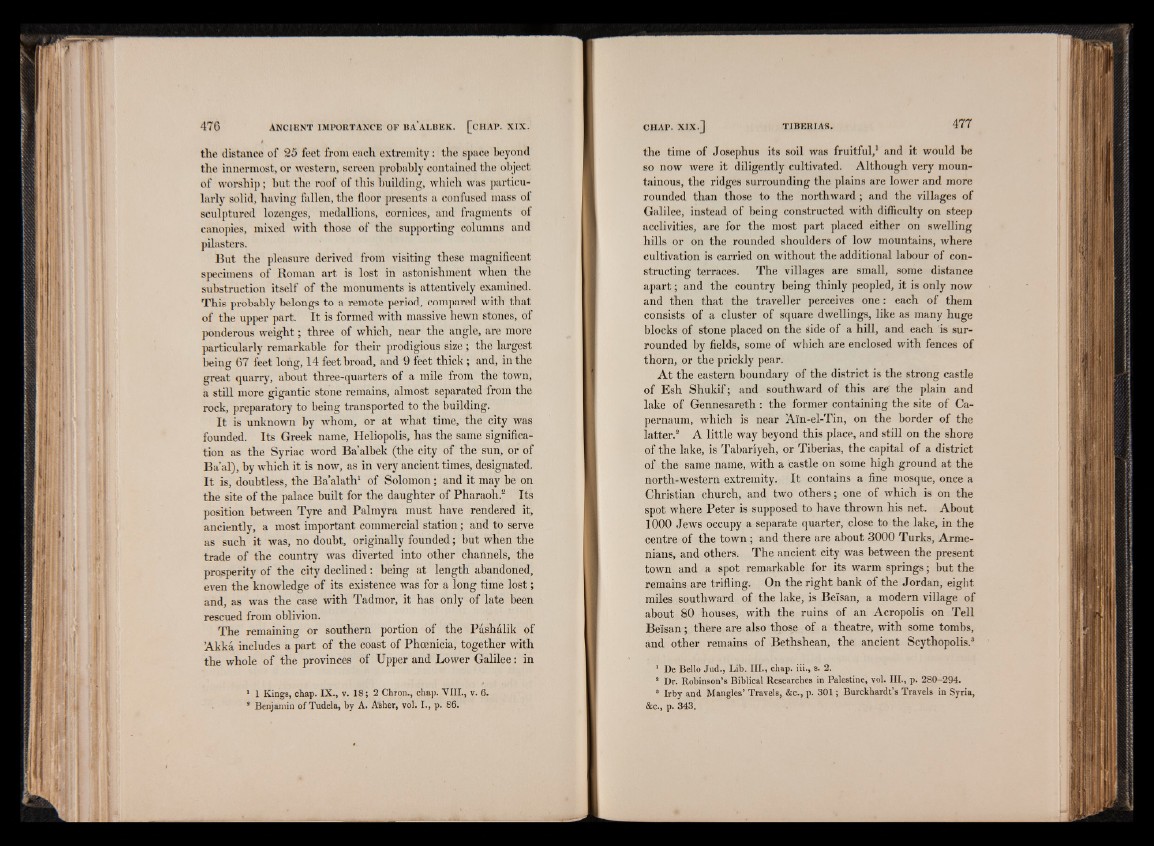
the distance of 25 feet from each extremity: the space beyond
the innermost, or western, screen probably contained the object
of worship; but the roof of this building, which was particularly
solid, having fallen, the floor presents a confused mass of
sculptured lozenges, medallions, cornices, and fragments oi
canopies, mixed with those of the supporting columns and
pilasters.
But the pleasure derived from visiting these magnificent
specimens of Roman art is lost in astonishment when the
substruction itself of the monuments is attentively examined.
This probably belongs to a remote period, compared with that
of the upper part. It is formed with massive hewn stones, of
ponderous weight; three of which, near the angle, are more
particularly remarkable for their prodigious size ; the largest
being 67 feet long, 14 feet broad, and 9 leet thick; and, in the
great quarry, about three-quarters of a mile from the town,
a still more gigantic stone remains, almost separated from the
rock, preparatory to being transported to the building.
It is unknown by whom, or at what time, the city was
founded. Its Greek name, Heliopolis, has the same signification
as the Syriac word Ba’albek (the city of the sun, or of
Ba’al), by which it is now, as in very ancient times, designated.
It is, doubtless, the Ba’alath1 of Solomon; and it may be on
the site of the palace built for the daughter of Pharaoh.2 Its
position between Tyre and Palmyra must have rendered it,
anciently, a most important commercial station; and to serve
as such it was, no doubt, originally founded; but when the
trade of the country was diverted into other channels, the
prosperity of the city declined: being at length abandoned,
even the knowledge of its existence was for a long time lo st;
and, as was the case with Tadmor, it has only of late been
rescued from oblivion.
The remaining or southern portion of the Pashalik of
Akka includes a part of the coast of Phoenicia, together with
the whole of the provinces of Upper and Lower Galilee: in
1 1 Kings, chap. IX., v. 18; 2 Chron., chap. VIII., v. 6.
8 Benjamin of Tudela, by A. A'sher, vol. I., p. 86.
the time of Josephus its soil was fruitful,1 and it would be
so now were it diligently cultivated. Although very mountainous,
the ridges surrounding the plains are lower and more
rounded than those to the northward; and the villages of
Galilee, instead of being constructed with difficulty on steep
acclivities, are for the most part placed either on swelling
hills or on the rounded shoulders of low mountains, where
cultivation is carried on without the additional labour of constructing
terraces. The villages are small, some distance
apart; and the country being thinly peopled, it is only now
and then that the traveller perceives one: each of them
consists of a cluster of square dwellings, like as many huge
blocks of stone placed on the side of a hill, and each is surrounded
by fields, some of which are enclosed with fences of
thorn, or the prickly pear.
At the eastern boundary of the district is the strong castle
of Esh Shukif; and southward of this are' the plain and
lake of Gennesareth : the former containing the site of Capernaum,
which is near Ain-el-Tin, on the border of the
latter.2 A little way beyond this place, and still on the shore
of the lake, is Tabariyeh, or Tiberias, the capital of a district
of the same name, with a castle on some high ground at the
north-western extremity. It contains a fine mosque, once a
Christian church, and two others; one of which is on the
spot where Peter is supposed to have thrown his net. About
1000 Jews occupy a separate quarter, close to the lake, in the
centre of the town; and there are about 3000 Turks, Armenians,
and others. The ancient city was between the present
town and a spot remarkable for its warm springs; but the
remains are trifling. On the right bank of the Jordan, eight
miles southward of the lake, is Beisan, a modern village of
about 80 houses, with the ruins of an Acropolis on Tell
Beisan; there are also those of a theatre, with some tombs,
and other remains of Bethshean, the ancient Scythopolis.3
1 De Bello Jud., Lib. Ill , chap. iii., s. 2.
8 Dr. Robinson’s Biblical Researches in Palestine, vol. III., p. 280—294.
8 Irby and Mangles’ Travels, &c., p. 301; Burckhardt’s Travels in Syria,
&c., p. 343.